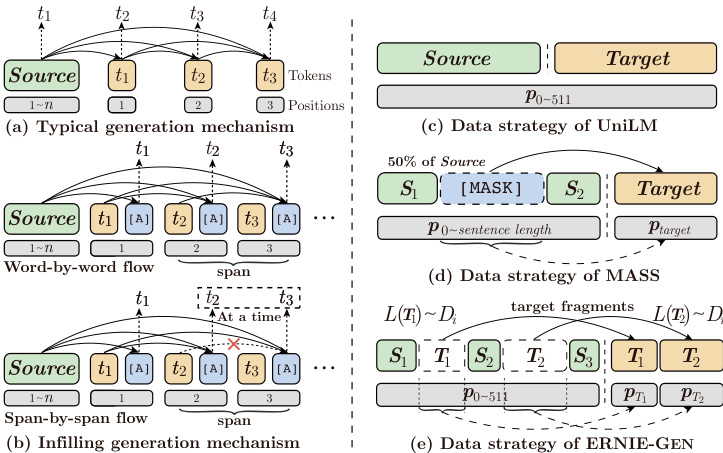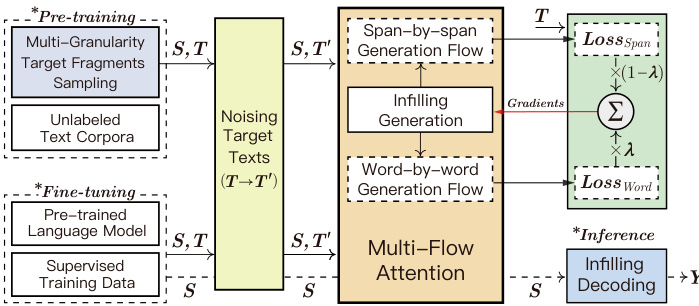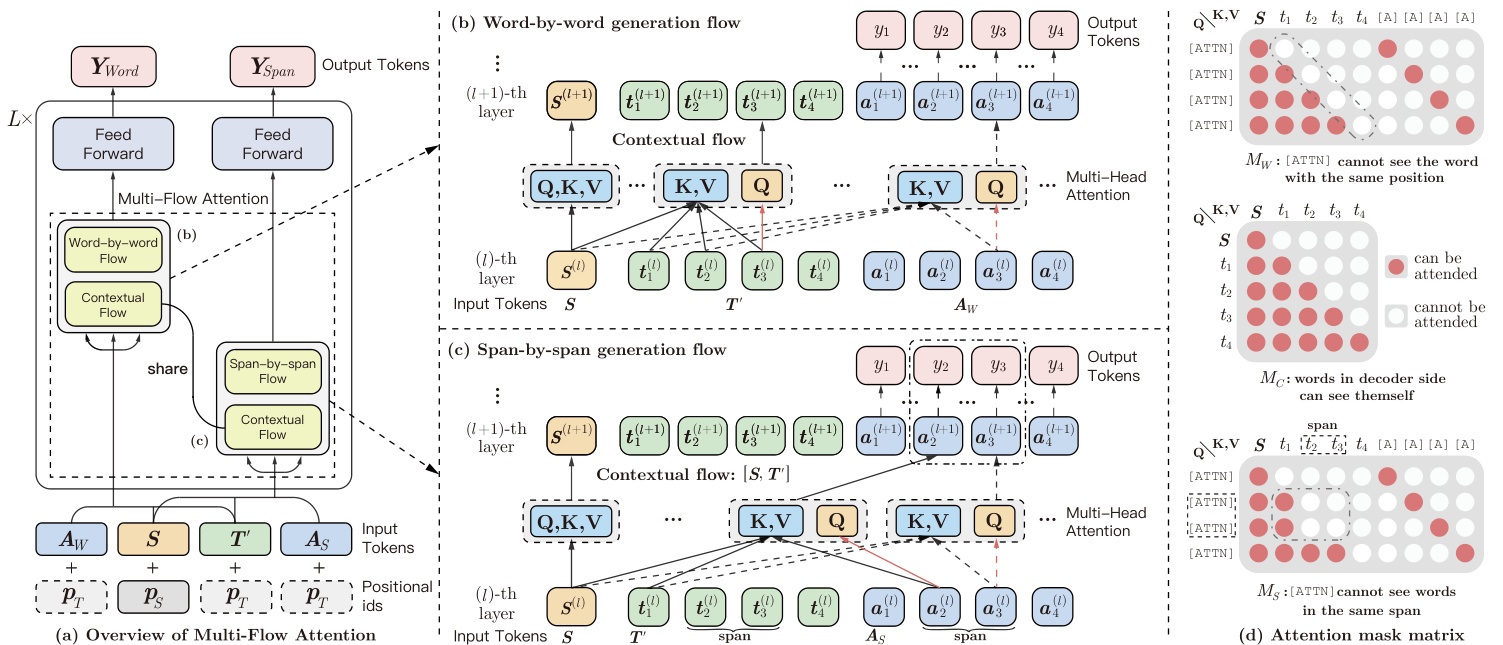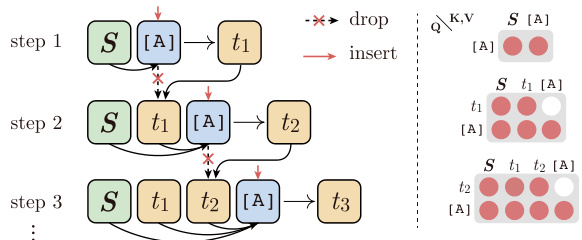ERNIE-GEN: An Enhanced Multi-Flow Pre-training and Fine-tuning Framework for Natural Language Generation
ERNIE-GEN: 面向自然语言生成的增强型多流预训练与微调框架
Abstract
摘要
Current pre-training works in natural language generation pay little attention to the problem of exposure bias on downstream tasks. To address this issue, we propose an enhanced multi-flow sequence to sequence pre-training and fine-tuning framework named ERNIE-GEN, which bridges the discrepancy between training and inference with an infilling generation mechanism and a noise-aware generation method. To make generation closer to human writing patterns, this framework introduces a span-by-span generation flow that trains the model to predict semantically-complete spans consecutively rather than predicting word by word. Unlike existing pre-training methods, ERNIE-GEN incorporates multi-granularity target sampling to construct pre-training data, which enhances the correlation between encoder and decoder. Experimental results demonstrate that ERNIE-GEN achieves state-of-the-art results with a much smaller amount of pre-training data and parameters on a range of language generation tasks, including abstract ive sum mari z ation (Gigaword and CNN/DailyMail), question generation (SQuAD), dialogue response generation (Persona-Chat) and generative question answering (CoQA). The source codes and pretrained models have been released at https://github. com/Paddle Paddle/ERNIE.
当前自然语言生成领域的预训练工作很少关注下游任务中的曝光偏差问题。为解决这一问题,我们提出了名为ERNIE-GEN的增强型多流程序列到序列预训练与微调框架,该框架通过填充生成机制和噪声感知生成方法弥合了训练与推理之间的差异。为使生成更接近人类写作模式,该框架引入了逐片段生成流程,训练模型连续预测语义完整的片段而非逐词预测。与现有预训练方法不同,ERNIE-GEN采用多粒度目标采样构建预训练数据,增强了编码器与解码器之间的关联性。实验结果表明,在抽象摘要生成(Gigaword和CNN/DailyMail)、问题生成(SQuAD)、对话响应生成(Persona-Chat)以及生成式问答(CoQA)等一系列语言生成任务中,ERNIE-GEN以更少的预训练数据和参数量取得了最先进的性能。源代码与预训练模型已发布于https://github.com/PaddlePaddle/ERNIE。
1 Introduction
1 引言
Pre-trained on large-scale unlabeled text corpora and finetuned on downstream tasks, self-supervised representation models such as GPT [Radford et al., 2018], BERT [Devlin et al., 2019] and XLNet [Yang et al., 2019b] have achieved remarkable improvements in natural language understanding (NLU). Different from encoder-only pre-training like BERT or decoder-only pre-training like GPT, natural language generation (NLG) relies on the sequence to sequence generation framework (seq2seq) which consists of a bidirectional encoder and a unidirectional decoder. Current pre-training works in NLG such as MASS [Song et al., 2019] and UNILM [Dong et al., 2019] mainly focus on jointly pre-training encoder and decoder on different self-supervised tasks. However, these works pay little attention to the exposure bias issue [Ranzato et al., 2016], a major drawback of teacher-forcing training. This issue is due to the fact that ground truth words are used during training, while generated words, whether predicted correctly or not, are used for inference where mistakes tend to accumulate. To alleviate this issue, we present ERNIE-GEN, an enhanced multi-flow seq2seq training framework characterized by a carefully-designed MultiFlow Attention architecture based on Transformer [Vaswani et al., 2017], as illustrated in Figure 2. ERNIE-GEN incorporates a novel infilling generation mechanism and a noiseaware generation method into pre-training and fine-tuning, which is proved to be effective through experiments in $\S4.3$ .
在大规模无标注文本语料上进行预训练并在下游任务上微调的自监督表示模型,如GPT [Radford et al., 2018]、BERT [Devlin et al., 2019]和XLNet [Yang et al., 2019b],在自然语言理解(NLU)领域取得了显著进步。与BERT这类仅编码器的预训练或GPT这类仅解码器的预训练不同,自然语言生成(NLG)依赖于由双向编码器和单向解码器组成的序列到序列生成框架(seq2seq)。当前NLG领域的预训练工作如MASS [Song et al., 2019]和UNILM [Dong et al., 2019]主要聚焦于在不同自监督任务上联合预训练编码器和解码器。然而,这些工作很少关注教师强制训练的主要缺陷——曝光偏差问题[Ranzato et al., 2016]。该问题源于训练时使用真实词汇,而推理时无论预测正确与否都使用生成词汇,导致错误容易累积。为缓解此问题,我们提出了ERNIE-GEN,这是一个基于Transformer [Vaswani et al., 2017]的多流注意力架构精心设计的增强型多流seq2seq训练框架,如图2所示。ERNIE-GEN将新颖的填充生成机制和噪声感知生成方法融入预训练与微调过程,其有效性通过$\S4.3$节的实验得到验证。

Figure 1: Schematic of two generation mechanisms (left) and data strategies for pre-training (right). Blocks in green, orange and blue denote source texts, target texts and artificial symbols.
图 1: 两种生成机制示意图 (左) 和预训练数据策略 (右)。绿色、橙色和蓝色区块分别表示源文本、目标文本和人工符号。
• Infilling generation. Instead of using last ground truth word in training or last generated word in inference, we adopt an inserted artificial symbol [ATTN] along with its position to gather history contextual representations at each step in both training and inference, which diverts model’s attention away from last word and coerces it into focusing on all former representations, thus alleviating negative influence of previous mistakes to subsequent generation, as shown in Figure 1(b).
• 填充生成 (Infilling generation)。与训练时使用最后一个真实词或推理时使用最后一个生成词不同,我们在训练和推理的每一步都插入一个人工符号 [ATTN] 及其位置来收集历史上下文表征。这种方法将模型的注意力从最后一个词转移开,迫使其关注所有先前的表征,从而减轻先前错误对后续生成的负面影响,如图 1(b) 所示。
• Noise-Aware generation. We corrupt the input target sequence by randomly replacing words to arbitrary words in the vocabulary. This setup, despite its simplicity, proves to be an effective way to make the model be aware of mistakes in training, so that the model is able to detect mistakes and ignore them during inference.
• 噪声感知生成 (Noise-Aware generation)。我们通过随机替换词汇表中的任意单词来破坏输入目标序列。尽管这种设置很简单,但事实证明,这是一种让模型意识到训练中错误的有效方法,从而使模型能够在推理过程中检测并忽略这些错误。

Figure 2: Overview of ERNIE-GEN framework. ${S,T}$ and $\mathbf{Y}$ donate source, target, and generated texts, $\pmb{T}^{\prime}$ is the noised version of $_{\pmb{T}}$ .
图 2: ERNIE-GEN 框架概览。${S,T}$ 和 $\mathbf{Y}$ 分别表示源文本、目标文本和生成文本,$\pmb{T}^{\prime}$ 是 $_{\pmb{T}}$ 的噪声版本。
Moreover, in light of the fact that entities, phrases and sentences in human writing are organized in a coherent manner, we incorporate a span-by-span generation task into ERNIEGEN as a new generation flow to train the model to predict semantically-complete spans consecutively rather than predicting word by word as traditional models do. This task is implemented through the infilling generation mechanism in parallel with an infilling-based word-by-word generation flow to facilitate convergence in training, as shown in Figure 1b.
此外,鉴于人类写作中的实体、短语和句子是以连贯方式组织的,我们在ERNIEGEN中引入了一个逐片段生成任务作为新的生成流程,训练模型连续预测语义完整的片段,而非像传统模型那样逐词预测。该任务通过填充生成机制实现,并与基于填充的逐词生成流程并行运行以促进训练收敛,如图1b所示。
In addition, as shown in Figure 1(c-d), recent pre-training works for NLG like UNILM and MASS only sample a single continuous segment as target sequence. However, this sampling method compromises the correlation between encoder and decoder when it comes to pre-training of long texts (typically 512 words), given that adjacent segments are often relevant semantically. ERNIE-GEN adopts a multi-granularity target fragments sampling strategy to force decoder to rely more on the encoder representations other than the previous generated words, thus enhancing the correlation between encoder and decoder, as shown in Figure 1e.
此外,如图 1(c-d) 所示,近期 UNILM 和 MASS 等自然语言生成 (NLG) 预训练工作仅采样单个连续片段作为目标序列。然而这种采样方法会损害长文本 (通常为 512 词) 预训练时编码器与解码器的关联性,因为相邻片段往往具有语义相关性。ERNIE-GEN 采用多粒度目标片段采样策略,迫使解码器更多地依赖编码器表征而非先前生成的词,从而增强编码器与解码器的关联性,如图 1e 所示。
Empirically, ERNIE-GEN is particularly effective and achieves state-of-the-art results on a range of NLG tasks including abstract ive sum mari z ation (Gigaword and CNN/DailyMail), question generation (SQuAD), dialogue response generation (Persona-Chat) and generative question answering (CoQA), utilizing a much smaller amount of pretraining data and parameters.
实证表明,ERNIE-GEN 在多项自然语言生成任务中表现尤为出色,仅使用少量预训练数据和参数,便在摘要生成 (Gigaword 和 CNN/DailyMail)、问题生成 (SQuAD)、对话响应生成 (Persona-Chat) 以及生成式问答 (CoQA) 任务上取得了最先进的结果。
2 Related Work
2 相关工作
Pre-training for NLP Tasks. Recently, pre-training methods have achieved state-of-the-art results in multiple NLU tasks. ELMo [Peters et al., 2018] pre-trains two unidirectional language models (LMs) with forward and backward direction respectively to feature downstream tasks. GPT utilizes an adjusted Transformer [Vaswani et al., 2017] to learn a forward LM and then fine-tunes the forward LM on supervised datasets. BERT proposes a masked language modeling (MLM) task to learn deep bidirectional representations. Nevertheless, above methods are usually implemented by just one encoder or decoder, which is less effective in encoder-decoder based generation tasks, thus several works have preliminarily explored the pre-training towards NLG by incorporating BERT’s MLM into the seq2seq framework and shown excellent performance on a range of generation tasks. MASS masks a consecutive fragment $(50%)$ of the input sentence with [MASK] symbols to predict. UNILM masks several words in the input sequence which is a pair of segments for encoder and decoder, and then predicts the masked words in accordance with BERT’s MLM.
自然语言处理任务的预训练。近年来,预训练方法在多项自然语言理解任务中取得了最先进的成果。ELMo [Peters et al., 2018] 分别通过前向和后向语言模型进行预训练,为下游任务提供特征表示。GPT 采用改进版 Transformer [Vaswani et al., 2017] 学习前向语言模型,然后在监督数据集上微调该模型。BERT 提出掩码语言建模 (MLM) 任务来学习深度双向表征。然而上述方法通常仅使用单个编码器或解码器实现,在基于编码器-解码器的生成任务中效果有限。为此,部分研究通过将 BERT 的 MLM 融入 seq2seq 框架,初步探索了面向自然语言生成的预训练方法,在一系列生成任务中展现出优异性能。MASS 使用 [MASK] 符号遮盖输入句中连续片段 $(50%)$ 进行预测。UNILM 对编码器-解码器双段输入序列中的多个词进行掩码,然后按照 BERT 的 MLM 方式预测被掩词汇。
Exposure Bias Issue. NLG tasks suffer from the exposure bias which is caused by teacher-forcing training. To address such issue, RNN-based variation al auto encoders (VAEs) are leveraged in [Yang et al., 2019a; Wang et al., 2019], whereas it requires inference for both posterior and prior distribution. Reinforcement learning is also adopted to text generation against exposure bias issue [Ranzato et al., 2016; Wang et al., 2018], which is, however, inefficient during training because of the word-by-word sampling procedure. These methods are inefficient and less practical for pretraining that relies on large-scale unlabeled text corpora.
曝光偏差问题。自然语言生成任务存在由教师强制训练导致的曝光偏差问题。为解决该问题,[Yang et al., 2019a; Wang et al., 2019] 采用了基于RNN的变分自编码器 (VAEs),但该方法需要同时推断后验分布和先验分布。强化学习也被用于对抗曝光偏差的文本生成任务 [Ranzato et al., 2016; Wang et al., 2018],然而由于逐词采样的训练过程,这类方法效率较低。这些方法对于依赖大规模无标注文本语料的预训练任务而言效率不足且实用性有限。
Span-level Pre-training. [Sun et al., 2019; Sun et al., 2020; Joshi et al., 2019] verify that predicting spans reaches substantially better performance on NLU tasks. Meanwhile, inspired by characteristics of human expression, we hope the model have the foresight to generate a semantically-complete span at each step rather than a word. Consequently, a spanby-span generating task is proposed to make the model capable of generating texts more human-like.
Span-level 预训练。 [Sun et al., 2019; Sun et al., 2020; Joshi et al., 2019] 验证了预测文本片段 (span) 在自然语言理解 (NLU) 任务中能显著提升性能。同时,受人类表达特点的启发,我们希望模型在每一步都能前瞻性地生成语义完整的片段而非单个词汇。因此,我们提出了逐片段生成任务,使模型能够生成更接近人类表达的文本。
3 Proposed Framework
3 提出的框架
Built on infilling generation mechanism, ERNIE-GEN adopts a Multi-Flow Attention architecture to train the model on word-by-word and span-by-span generation tasks in parallel. In this section, we describe ERNIE-GEN according to the training process shown in Figure 2.
基于填充生成机制,ERNIE-GEN采用多流注意力架构,在逐词生成和跨片段生成任务上并行训练模型。本节将根据图2所示的训练流程描述ERNIE-GEN。
3.1 Multi-Granularity Target Fragments
3.1 多粒度目标片段
Given an input sequence ${ S}~={s_{1},...,s_{n}}$ , we first sample a length distribution $D_{i}$ from a distribution set ${{D}}=$ ${D_{1},...,D_{|D|}}$ with probability $p_{i}$ for target fragments, and then select fragments according to $D_{i}$ in ${S}$ iterative ly until the fragment budget has been spent (e.g. $25%$ of ${S}$ ). We denote $S_{j}^{i}$ as the $j$ -th fragment which is sampled in length distribution $D_{i}$ . Sampled fragments are then removed from ${S}$ and stitched together to form target sequence ${T}=[T_{1},...,T_{k}]=$ $[S_{1}^{i},...,S_{k}^{i}]$ . We denote $S^{\prime}$ as the left input sequence after removing sampled fragments. ERNIE-GEN performs pretraining by predicting the fragmented target sequence ${T}$ and minimizing the negative log likelihood:
给定输入序列 ${\cal S}~={s_{1},...,s_{n}}$ ,首先从分布集 $\textbf{\textit{D}}=$ ${D_{1},...,D_{|D|}}$ 中按概率 $p_{i}$ 采样目标片段的长度分布 $D_{i}$ ,然后在 $\boldsymbol{S}$ 中根据 $D_{i}$ 迭代选择片段直至耗尽片段预算 (例如 $\pmb{S}$ 的 $25%$ )。将 $S_{j}^{i}$ 表示为按长度分布 $D_{i}$ 采样的第 $j$ 个片段。采样后的片段从 $\boldsymbol{S}$ 中移除并拼接形成目标序列 $\pmb{T}=[T_{1},...,T_{k}]=$ $[S_{1}^{i},...,S_{k}^{i}]$ 。用 $S^{\prime}$ 表示移除采样片段后剩余的输入序列。ERNIE-GEN通过预测分段目标序列 $\pmb{T}$ 并最小化负对数似然进行预训练:
$$
\begin{array}{l}{\displaystyle\mathcal{L}(\boldsymbol{\theta};\boldsymbol{S},D_{i})=-\mathrm{log}P(T|\boldsymbol{S}^{\prime},D_{i};\boldsymbol{\theta})}\ {\displaystyle=-\mathrm{log}\prod_{j=1}^{k}P(T_{j}|T_{<j},\boldsymbol{S}^{\prime},D_{i};\boldsymbol{\theta}).}\end{array}
$$
$$
\begin{array}{l}{\displaystyle\mathcal{L}(\boldsymbol{\theta};\boldsymbol{S},D_{i})=-\mathrm{log}P(T|\boldsymbol{S}^{\prime},D_{i};\boldsymbol{\theta})}\ {\displaystyle=-\mathrm{log}\prod_{j=1}^{k}P(T_{j}|T_{<j},\boldsymbol{S}^{\prime},D_{i};\boldsymbol{\theta}).}\end{array}
$$
where the target sequence $\mathbf{\delta}{\mathbf{{T}}}$ is sorted by the positions of sampled fragments. For each fragment $\dot{T={t_{1},...,t_{|T|}}}$ in $\pmb{T}$ , we have $\begin{array}{r}{P(T)=\prod_{j=1}^{|T|}P(t_{j}|t_{<j})}\end{array}$ .
目标序列 $\mathbf{\delta}{\mathbf{{T}}}$ 按采样片段的位置排序。对于 $\pmb{T}$ 中的每个片段 $\dot{T={t_{1},...,t_{|T|}}}$ ,我们有 $\begin{array}{r}{P(T)=\prod_{j=1}^{|T|}P(t_{j}|t_{<j})}\end{array}$ 。

Figure 3: Illustration of the Multi-Flow Attention module. (a):Overview of multi-flow attention. The encoder and the decoder share the parameters of multi-layer Transformer. (b):Word-by-word generation flow with history contextual representations from Contextual Flow. (c):Spanby-span generation flow with shared Contextual Flow. (d):The attention mask matrixes of word-by-word generation flow $(M_{W})$ , contextual flow $(M_{C})$ and span-by-span generation flow $(M_{S})$ . The $i$ -th generated token $y_{i}$ is calculated by argmax(softmax( $\operatorname{Ec}(\pmb{a}_{i}^{(L-1)}))$ ).
图 3: 多流注意力模块示意图。(a): 多流注意力概览。编码器与解码器共享多层Transformer参数。(b): 基于上下文流历史表征的逐词生成流。(c): 共享上下文流的逐片段生成流。(d): 逐词生成流 $(M_{W})$、上下文流 $(M_{C})$ 和逐片段生成流 $(M_{S})$ 的注意力掩码矩阵。第 $i$ 个生成token $y_{i}$ 通过argmax(softmax( $\operatorname{Ec}(\pmb{a}_{i}^{(L-1)}))$ )计算得出。
Following preliminary trials, we set a hyper parameter $\gamma=$ 0.25, which denotes the ratio of length of all fragments to that of the input sequence $\pmb{S}$ . Besides, we introduce two uniform distributions $\bar{D}={U(1,4),U(4,32)}$ with probability of 0.4 and 0.6 respectively to sample fragments, which aims to learn representations from different perspectives. On the one hand, short fragments benefit learning of semantic relation between words; on the other hand, longer fragments help to memorize sentence-level expressions.
经过初步试验,我们将超参数设为 $\gamma=$ 0.25,该参数表示所有片段长度与输入序列 $\pmb{S}$ 长度的比值。此外,我们引入两个均匀分布 $\bar{D}={U(1,4),U(4,32)}$,分别以0.4和0.6的概率进行片段采样,旨在从不同角度学习表征。一方面,短片段有助于学习词语间的语义关系;另一方面,长片段有助于记忆句子级表达。
3.2 Noise-Aware Generation
3.2 噪声感知生成
To train a generation model which can detect the false prediction and mitigate its impact on subsequent generation, we corrupt the ground truth sequence $\mathbf{\delta}{\mathbf{{T}}}$ with a procedure where words are being replaced randomly, and the corrupted $\pmb{T}$ is represented as $\pmb{T}^{\prime}$ . There are two hyper parameters, $\rho_{p}$ and $\rho_{f}$ , denoting the noising rate in pre-training and fine-tuning respectively.
为了训练一个能够检测错误预测并减轻其对后续生成影响的生成模型,我们通过随机替换单词的方式对真实序列$\mathbf{\delta}{\mathbf{{T}}}$进行干扰,干扰后的$\pmb{T}$表示为$\pmb{T}^{\prime}$。该过程涉及两个超参数:$\rho_{p}$和$\rho_{f}$,分别表示预训练和微调阶段的噪声率。
3.3 Architecture: Multi-Flow Attention
3.3 架构:多流注意力机制
Formally, given a source sequence $S={s_{1},...,s_{n}}$ , a noised target sequence $\pmb{T}^{\prime}={t_{1},...,t_{m}}$ , we denote the inference of seq2seq network based on shared Transformer as follows:
给定源序列 $S={s_{1},...,s_{n}}$ 和带噪声的目标序列 $\pmb{T}^{\prime}={t_{1},...,t_{m}}$ ,我们将基于共享Transformer的seq2seq网络推理表示如下:
$$
\begin{array}{r}{{s}{i}^{(l+1)}\gets\mathtt{M H\mathrm{-}R t\mathrm{tn}}\big(Q={s}_{i}^{(l)},K V=S^{(l)}\big).}\end{array}
$$
$$
\begin{array}{r}{{s}{i}^{(l+1)}\gets\mathtt{M H\mathrm{-}R t\mathrm{tn}}\big(Q={s}_{i}^{(l)},K V=S^{(l)}\big).}\end{array}
$$
$$
\pmb{t}{i}^{(l+1)}\gets\mathtt{M H\mathrm{-}R t}\mathsf{t}\mathsf{t}\mathsf{n}(Q=\pmb{t}{i}^{(l)},K V=\left[\pmb{S}^{(l)},\pmb{t}_{\le i}^{(l)}\right]).
$$
$$
\pmb{t}{i}^{(l+1)}\gets\mathtt{M H\mathrm{-}R t}\mathsf{t}\mathsf{t}\mathsf{n}(Q=\pmb{t}{i}^{(l)},K V=\left[\pmb{S}^{(l)},\pmb{t}_{\le i}^{(l)}\right]).
$$
where $Q,K,V$ denote the query, key, and value in MultiHead attention [Vaswani et al., 2017]. $\mathbf{\pmb{\mathscr{s}}}{i}^{(l)}$ and $\pmb{t}_{i}^{(l)}$ indicate the $i$ -th vector representations of the $l$ -th layer of Multi-Head Attention for the encoder and the decoder respectively, $[\cdot]$ denotes the concatenation operation. In this work, we call the above procedure the Contextual Flow.
其中 $Q,K,V$ 表示多头注意力 (MultiHead attention) [Vaswani et al., 2017] 中的查询(query)、键(key)和值(value)。$\mathbf{\pmb{\mathscr{s}}}{i}^{(l)}$ 和 $\pmb{t}_{i}^{(l)}$ 分别表示编码器和解码器第 $l$ 层多头注意力的第 $i$ 个向量表示,$[\cdot]$ 表示拼接操作。在本研究中,我们将上述过程称为上下文流 (Contextual Flow)。
Word-by-word Generation Flow. Based on infilling generation mechanism, this flow utilizes an inserted [ATTN] symbol to gather history representations word by word (see Figure 1b). To facilitate this process, we place all inserted [ATTN] together to construct an artificial symbol sequence $A_{W}={~[{ATTN}]{1},...,[ATTN]_{m}}$ which has the same length as $\pmb{T}^{\prime}$ , as shown in Figure 3b. To be specific, the word-byword generation flow is updated as follow:
逐词生成流程。基于填充生成机制,该流程通过插入的[ATTN]符号逐词收集历史表征(见图1b)。为实现这一过程,我们将所有插入的[ATTN]集中排列,构建人工符号序列$A_{W}={~[{ATTN}]{1},...,[ATTN]_{m}}$,其长度与$\pmb{T}^{\prime}$相同,如图3b所示。具体而言,逐词生成流程按以下方式更新:
$$
\pmb{a}{i}^{(l+1)}\gets\mathtt{M H\mathrm{-}A t t n}(Q=\pmb{a}{i}^{(l)},K V=\left[\pmb{S}^{(l)},\pmb{t}{<i}^{(l)},\pmb{a}_{i}^{(l)}\right]).
$$
$$
\pmb{a}{i}^{(l+1)}\gets\mathtt{M H\mathrm{-}A t t n}(Q=\pmb{a}{i}^{(l)},K V=\left[\pmb{S}^{(l)},\pmb{t}{<i}^{(l)},\pmb{a}_{i}^{(l)}\right]).
$$
where ai(l) indicates the i-th vector representation of the l-th layer for the artificial symbol sequence $\pmb{A}_{W}$ .
其中ai(l)表示人工符号序列$\pmb{A}_{W}$第l层的第i个向量表示。
Span-by-span Generation Flow. Different from word-byword generation flow, span-by-span flow uses [ATTN] symbols to predict spans consecutively, as shown in Figure 3c. Formally, given a list of span boundaries $B={b_{1},...,b_{|B|}}$ , we conduct the span-by-span generation flow as:
分跨度生成流程。与逐词生成流程不同,分跨度流程使用[ATTN]符号连续预测跨度,如图3c所示。形式上,给定跨度边界列表$B={b_{1},...,b_{|B|}}$,我们执行分跨度生成流程如下:
$$
\pmb{a}{j}^{(l+1)}\gets\mathtt{M H\mathrm{-}A t t n}(Q=\pmb{a}{j}^{(l)},K V=\left[\pmb{S}^{(l)},\pmb{t}{<b_{i}}^{(l)},\pmb{a}_{j}^{(l)}\right]).
$$
$$
\pmb{a}{j}^{(l+1)}\gets\mathtt{M H\mathrm{-}A t t n}(Q=\pmb{a}{j}^{(l)},K V=\left[\pmb{S}^{(l)},\pmb{t}{<b_{i}}^{(l)},\pmb{a}_{j}^{(l)}\right]).
$$
where j ∈ [bi, bi+1), and a(jl) denotes the $(j-b_{i})$ -th vector representation of the $i$ -th span. Essentially, the model is trained to predict a whole span ${t_{b_{i}},...,t_{b_{i+1}-1}}$ with the same history context $[S,t_{<b_{i}}]$ . Instead of randomly sampling spans, we prefer sampling spans with semantical information and knowledge. Specifically, we consider the following two steps to sample spans consecutively in $\pmb{T}^{\prime}$ :
其中j ∈ [bi, bi+1),a(jl)表示第i个跨度的第$(j-b_{i})$个向量表示。本质上,模型被训练为预测整个跨度${t_{b_{i}},...,t_{b_{i+1}-1}}$,使用相同的历史上下文$[S,t_{<b_{i}}]$。我们不是随机采样跨度,而是倾向于采样具有语义信息和知识的跨度。具体来说,我们考虑以下两个步骤在$\pmb{T}^{\prime}$中连续采样跨度:
• Firstly, we implement a T-test to compute ${\bf t}$ -statistic scores of all bigrams and trigrams, which is based on an initial hypothesis $H_{0}$ : a random span of $n$ arbitrary words ${\pmb w}=$ ${w_{1},...,w_{n}}$ with probability $\begin{array}{r}{p^{\prime}(\pmb{w})=\prod_{i=1}^{n}\stackrel{\cdot}{p}(w_{i})}\end{array}$ cannot be a statistical $n$ -gram. The t-statistic sc ore is calculated by $\frac{\left(p(\pmb{w})-p^{\prime}(\pmb{w})\right)}{\sqrt{\sigma^{2}/N}}$ , where $\begin{array}{r}{p(\pmb{w})=\frac{\complement\mathrm{ount}(\pmb{w})}{N}}\end{array}$ and $\sigma^{2}=p(\pmb{w})(1-$ $p(\pmb{w}))$ , indicating the statistic probability and the standard deviation of $\mathbf{\nabla}_{\mathbf{\overrightarrow{\nabla}}\mathbf{\overrightarrow{\omega}}}$ respectively, $N$ denotes the total number of $n$ -grams appearing in the training data. According to the t-statistic scores, we select the top 200,000 bigrams, top 50,000 trigrams and all unigrams to construct a specific vocabulary of spans, which is represented as $V_{s p a n}$ .
• 首先,我们实施T检验来计算所有二元组和三元组的 ${\bf t}$ 统计量得分,其基于初始假设 $H_{0}$:由 $n$ 个任意单词 ${\pmb w}=$ ${w_{1},...,w_{n}}$ 组成的随机片段,其概率 $\begin{array}{r}{p^{\prime}(\pmb{w})=\prod_{i=1}^{n}\stackrel{\cdot}{p}(w_{i})}\end{array}$ 不可能构成统计意义上的 $n$-gram。t统计量得分通过 $\frac{\left(p(\pmb{w})-p^{\prime}(\pmb{w})\right)}{\sqrt{\sigma^{2}/N}}$ 计算,其中 $\begin{array}{r}{p(\pmb{w})=\frac{\complement\mathrm{ount}(\pmb{w})}{N}}\end{array}$ 和 $\sigma^{2}=p(\pmb{w})(1-$ $p(\pmb{w}))$ 分别表示统计概率和 $\mathbf{\nabla}_{\mathbf{\overrightarrow{\nabla}}\mathbf{\overrightarrow{\omega}}}$ 的标准差,$N$ 表示训练数据中出现的 $n$-gram 总数。根据t统计量得分,我们选取前200,000个二元组、前50,000个三元组及所有一元组构建特定片段词汇表,记为 $V_{s p a n}$。
• Secondly, we search the trigram, bigram and unigram in order, starting with current word until a span $n$ -gram, $n\leq$ 3) is retrieved in $V_{s p a n}$ .
• 其次,我们从当前词开始依次搜索三元组、二元组和一元组,直到在 $V_{span}$ 中检索到跨度为 $n$ 的语法单元( $n\leq$ 3)。
where $\boldsymbol{X}$ denotes the concatenation of $\boldsymbol{S}$ and $\pmb{T}^{\prime}$ , $X^{(l)}$ is the vector sequence of the $l$ -th layer for the contextual flow. ${\pmb A}{W}^{(l)},{\pmb A}_{S}^{(l)}$ are vector sequences of the $l$ -th layer for the wordby-word and span-by-span generation flow respectively. As shown in Figure 3d, attention mask matrix $M$ determines whether query and key can attend to each other by modifying the attention weight W=softmax( Q√KdT [Vaswani et al., 2017] . Specifically, $M$ is assigned as:
其中 $\boldsymbol{X}$ 表示 $\boldsymbol{S}$ 和 $\pmb{T}^{\prime}$ 的拼接,$X^{(l)}$ 是第 $l$ 层上下文流的向量序列。${\pmb A}{W}^{(l)},{\pmb A}_{S}^{(l)}$ 分别是第 $l$ 层逐词生成流和逐片段生成流的向量序列。如图 3d 所示,注意力掩码矩阵 $M$ 通过修改注意力权重 W=softmax( Q√KdT [Vaswani et al., 2017] 来决定查询和键是否可以相互关注。具体来说,$M$ 被赋值为:
$$
M_{i j}={0}{canbeattended}.
$$
While training, we add the loss of the word-by-word and span-by-span generation flow with an coefficient $\lambda$ :
训练时,我们以系数$\lambda$加权相加逐词生成和逐片段生成流程的损失值:
$$
\begin{array}{r l}&{\mathcal{L}(\pmb{T})=\lambda\mathcal{L}{W o r d}(\pmb{T})+(1-\lambda)\mathcal{L}{S p a n}(\pmb{T})}\ &{\quad\quad=-\lambda\mathrm{log}P(\pmb{T}|\pmb{A}{W}^{(L-1)})-(1-\lambda)\mathrm{log}P(\pmb{T}|\pmb{A}_{S}^{(L-1)}).}\end{array}
$$
where $\mathbf{\delta}_{\mathbf{T}}$ indicates the unnoised target sequence, and $\mathcal{L}(\cdot)$ denotes the cross entropy loss function. In detail, we set $\lambda=0.5$ and $\lambda=1.0$ respectively in pre-training and fine-tuning.
其中 $\mathbf{\delta}_{\mathbf{T}}$ 表示未加噪的目标序列,$\mathcal{L}(\cdot)$ 表示交叉熵损失函数。具体而言,我们在预训练和微调阶段分别设置 $\lambda=0.5$ 和 $\lambda=1.0$。
3.4 Inference: Infilling Decoding
3.4 推理:填充解码
During inference, the target sequence $\mathbf{\delta}_{\mathbf{{T}}}$ is unknown, we insert symbol [ATTN] step by step to gather the representation of history context instead of preparing an artificial symbol sequence $\pmb{A}$ in advance. Meanwhile, for the purpose of efficiency, we need to drop the inserted [ATTN] after inference at each step, as detailed in Figure 4.
在推理过程中,目标序列 $\mathbf{\delta}_{\mathbf{{T}}}$ 是未知的,我们逐步插入符号 [ATTN] 来收集历史上下文的表示,而不是预先准备人工符号序列 $\pmb{A}$。同时,出于效率考虑,我们需要在每一步推理后丢弃插入的 [ATTN],如图 4 所示。
4 Experiments
4 实验
In this section, we compare our ERNIE-GEN with previous works and conduct several ablation experiments to assess the performance of proposed methods in $\S3$ .
在本节中,我们将ERNIE-GEN与先前工作进行比较,并通过多项消融实验评估$\S3$中提出方法的性能。
4.1 Pre-training and Implementation
4.1 预训练与实现
Analogous to BERT and UNILM, ERNIE-GEN is trained on English Wikipedia and BookCorpus [Zhu et al., 2015], totaling 16GB. We also pre-train ERNIE-GEN on larger scaled text corpora, which is specifically described in appendix A. The input sequence is lowercased and truncated to a maximum length of 512. We train a base model ERNIE $\mathbf{GEN}_{B A S E}$ ( $L{=}12$ , $H{=}768$ , $_{A=12}$ , Total Parameters ${\bf\Gamma}=110\mathbf{M})^{.}$ 1 and a large model ERNIE $\mathbf{GEN}_{L A R G E}$ $\scriptstyle{\mathcal{L}}=24$ , $H{=}1024$ , $A{=}16$ , Total Parameters $\mathbf{\mu}=340\mathbf{M})$ with parameters initialized by $\mathbf{B}\mathbf{ERT}_{B A S E}$ and $\mathbf{B}\mathbf{ERT}_{L A R G E}$ respectively. Specifically, Adam optimizer with $\beta_{1}~=~0.9,\beta_{2}~=~0.99\dot{9},\dot{\epsilon}~=~10^{-9}$ is employed. The peak learning rate is 5e-5 with warmup over the first 4,000 steps and linear decay scheduling. The noising rate $\rho_{p}$ for pre-training is 0.05. Batches are organized by limiting the maximum number of tokens to 196,608. Pre-training experiments are carried out on Paddle Paddle platforms2 and Nvidia Tesla V100 GPU. By virtue of float16 mixed precision training, it takes almost 4 days for 400,000 steps to train ERNIE $\mathbf{GEN}_{B A S E}$ while almost 7 days for 450,000 steps to train ERNIE-GENLARGE.
与BERT和UNILM类似,ERNIE-GEN在英文维基百科和BookCorpus [Zhu et al., 2015]上进行训练,总计16GB。我们还在更大规模的文本语料库上对ERNIE-GEN进行了预训练,具体描述见附录A。输入序列被转换为小写并截断至最大长度512。我们训练了一个基础模型ERNIE $\mathbf{GEN}_{B A S E}$ ( $L{=}12$ , $H{=}768$ , $_{A=12}$ , 总参数量 ${\bf\Gamma}=110\mathbf{M})^{.}$ 1和一个大模型ERNIE $\mathbf{GEN}_{L A R G E}$ $\scriptstyle{\mathcal{L}}=24$ , $H{=}1024$ , $A{=}16$ , 总参数量 $\mathbf{\mu}=340\mathbf{M})$ ,参数分别由 $\mathbf{B}\mathbf{ERT}_{B A S E}$ 和 $\mathbf{B}\mathbf{ERT}_{L A R G E}$ 初始化。具体采用Adam优化器,参数为 $\beta_{1}~=~0.9,\beta_{2}~=~0.99\dot{9},\dot{\epsilon}~=~10^{-9}$ 。峰值学习率为5e-5,前4,000步进行预热并采用线性衰减调度。预训练的噪声率 $\rho_{p}$ 为0.05。通过限制最大token数为196,608来组织批次。预训练实验在Paddle Paddle平台2和Nvidia Tesla V100 GPU上进行。借助float16混合精度训练,ERNIE $\mathbf{GEN}_{B A S E}$ 训练400,000步耗时约4天,而ERNIE-GENLARGE训练450,000步耗时约7天。

Figure 4: Schematic of infilling decoding: the particular procedures in infilling decoding including dropping and inserting (left) and the attention mask matrixes at each step (right).
图 4: 填充解码示意图:填充解码中的特定步骤包括丢弃和插入 (左) 以及每一步的注意力掩码矩阵 (右)。
4.2 Fine-tuning on Downstream Tasks
4.2 下游任务微调
Abstract ive Sum mari z ation aims at generating fluent and concise summaries without being constrained to extracting sub-sequences from the input articles. We execute experiments on Gigaword dataset [Rush et al., 2015] and CNN/DailyMail dataset [Hermann et al., 2015]. Gigaword dataset contains $3.8\mathbf{M}$ articles extracted from the Gigaword corpus, while CNN/DailyMail dataset consists of $93\mathrm{k\Omega}$ articles and $220\mathrm{k\Omega}$ articles from the CNN and Daily Mail respectively.
摘要式摘要旨在生成流畅简洁的摘要,而不受限于从输入文章中提取子序列。我们在Gigaword数据集[Rush等人,2015]和CNN/DailyMail数据集[Hermann等人,2015]上进行了实验。Gigaword数据集包含从Gigaword语料库中提取的$3.8\mathbf{M}$篇文章,而CNN/DailyMail数据集分别包含来自CNN和Daily Mail的$93\mathrm{k\Omega}$篇和$220\mathrm{k\Omega}$篇文章。
| 模型 | 数据参数量 | RG-1/RG-2/RG-L | |
|---|---|---|---|
| *10k训练样本:Gigaword10k | |||
| MASS [Song et al., 2019] | 18G | 160M | 25.03/9.48/23.48 |
| UNILM LARGE [Dong et al., 2019] | 16G | 340M | 32.96/14.68/30.56 |
| ERNIE-GEN BASE | 16G | 110M | 33.75/15.23/31.35 |
| ERNIE-GEN LARGE | 16G | 340M | 35.05/16.10/32.50 |
| *完整3.8M训练样本 | |||
| MASS [Song et al., 2019] | 18G | 160M | 37.66/18.53/34.89 |
| BERT SHARE [Rothe et al., 2019] | 16G | 110M | 38.13/19.81/35.62 |
| UNILM LARGE [Dong et al., 2019] | 16G | 340M | 38.45/19.45/35.75 |
| PEGASUS (c4) [Zhang et al., 2019] | 750G | 568M | 38.75/19.96/36.14 |
| PEGASUS (HugeNews) [Zhang et al., 2019] | 3.8T | 568M | 39.12/19.86/36.24 |
| ERNIE-GEN BASE | 16G | 110M | 38.83/20.04/36.20 |
| ERNIE-GEN LARGE | 16G | 340M | 39.25/20.25/36.53 |
Table 2: Comparison on Gigaword dataset with state-of-the-art results. Models in the upper block use 10k sample for fine-tuning. We also report the size of pre-training data and parameters utilized for each listed model (columns 2-3). RG is short for ROUGE.
表 2: Gigaword数据集与最先进结果的对比。上方模块中的模型使用1万样本进行微调。我们还列出了每个模型的预训练数据规模和参数量(第2-3列)。RG是ROUGE的缩写。
Table 1: Hyper paramters of fine-tuning for ERNIE $\mathrm{GEN}_{B A S E}$ and ERNIE-GENLARGE.
表 1: ERNIE $\mathrm{GEN}_{B A S E}$ 和 ERNIE-GENLARGE 微调的超参数
| 任务 | Epoch BASE | Epoch LARGE | Learni
